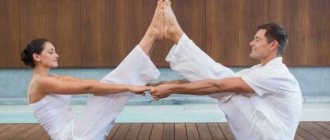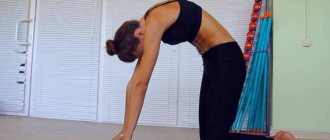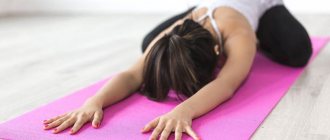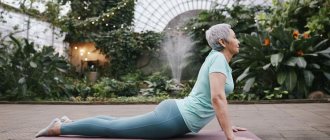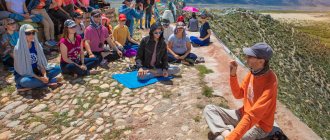Recently, various challenges, which translates from English as “challenge,” have become extremely popular on social networks. One of the most popular actions in which stars participated involved dousing them with ice water. Recently, the yoga challenge has been gaining momentum, but few people still know what it means.
Yoga challenge - benefits and harm
The benefits of challenges have already been mentioned, but the benefits of yoga itself cannot be excluded.
- Improves flexibility and makes muscles elastic.
- The benefits of the yoga challenge include the ability to lose excess weight.
- Forms beautiful posture and eliminates spinal curvature.
- Controls the production of stress hormones.
- Teaches you to feel and control your body.
- Gives strength and relieves bad mood.
- The couples yoga challenge helps people get closer and feel better about each other.
Yoga challenge - contraindications
In some situations, physical activity is prohibited, and this should be taken into account before accepting the challenge. There is a list regarding what contraindications the yoga challenge has:
- inflammatory diseases of internal organs;
- blood related problems;
- disturbances in the functioning of the heart and the condition of blood vessels;
- oncological diseases;
- period after surgery and serious illness;
- increased pressure and temperature;
- back problems and various injuries;
- ARVI, influenza and sore throat;
- pregnancy more than three months.
Breathing attunement for two
To benefit from the activity, you need to properly tune in to your partner. An incorrect condition can harm the entire process and lead to injury. Your first action should be to synchronize your breathing.
Difficulties that a beginner may encounter:
- At first it will be difficult to breathe calmly. When performing a complex action, you will want to pause, but this is the wrong tactic. With regular training, the skill will become automatic.
- You need to monitor not only the correctness of your actions, but also try to work in unison with your companion.
Harmonization methods:
- sit in the lotus position with your backs to each other (maximum touch from the tailbone to the back of the head);
- with your eyes closed, try to relax as much as possible;
- stretch your arms along your legs, place your hands, palms up, on your knees;
- listen to your partner’s breathing, even out the rhythm and duration;
- don’t rush to get out of this state, feel the moment;
- you can perform pranayamas together;
- after 5 minutes of attunement, proceed to training.
Pranayama is the control of vital energy through breathing exercises.
Simple asanas
Simple poses recommended for paired yoga are characterized by the absence of the need for extensive experience and developed muscles. Although in any position there is a principle of responsibility for the partner, therefore attentiveness and trust in the partner are necessary.
Trikonasana
- You need to stand one after the other, with both arms and legs spread wide. When the first leans to the right, he uses his right hand to push against his partner’s leg. Point your left hand upward, as well as your gaze.
- The partner makes similar movements, but in the opposite direction. As a result, the bodies will create a double triangle.
- You should remain in a static position for half a minute, then change the side of the inclination for each.
- To get out of this position, you need to rest your hand on your partner’s leg or your own limb.
Navasana
- You need to sit facing each other so that you can grab your partner’s wrists.
- While holding your hands, begin to gradually raise your legs, connecting them with your feet to your partner.
- Stretch your spine, straighten your lungs as much as possible. Look at your feet, keeping them flexed.
- If you feel comfortable, maintain this asana for a couple of minutes, leaning on your partner. Then slowly lower your limbs.
- Lie down on the floor, resting the tops of your heads with your partner. Move your hands to connect them with your partner's.
- Slowly lift your straight legs off the mat until they reach a right angle with your body. Try not to arch your lower back so that all vertebrae feel touching the floor.
- Try to achieve maximum relaxation by maintaining your balance for a couple of minutes. Then lower your legs, returning to the starting position. By clasping your hands, the load on the vertebrae is reduced.
We invite you to familiarize yourself with the Dream of the wife of an ex-lover
Paschimottanasana
- Sitting facing your partner, bring your feet together. Perform a synchronized forward lean of your bodies until you can grab your partner’s wrists or the area above them, if the stretch allows this.
- Using your grip, pull each other towards each other until you are as close as possible.
- Fix the pose and stay in it for two breathing cycles. Then release your hands, slowly straightening your back.
Yoga poses are designed for two, not only simple, but also complex. These asanas include the following poses:
- Adho mukha-svasana. Both partners lean their backs in a downward-facing dog position. Place your palms on the floor shoulder-width apart. Place your fingers parallel. Relax your shoulders and neck, look at your navel. One person should raise his left heel, the other – his right leg. They need to be connected. Lift the opposite legs up and bring them together with your knees straight. Externally, the positions of the bodies must be mirrored. Maintain the pose until your lungs have completed at least four breaths, then repeat the exercise in the opposite direction.
- Dhanurasvana. In the exercise, one partner lies down or performs a plank with straightened arms and legs. His lower back should be closed, allowing his partner to sit securely on top. The second partner clasps his partner’s shins with his hands, alternately placing his legs on his shoulders. You will also get a lying support, although in the opposite direction. Maintain a static pose for four breathing cycles.
- Dandasana. When performing the exercise, sit on the mat, bring your legs together and stretch them forward, pulling your toes towards you. Your partner should also sit opposite you, with his feet near his knees on the outside, with his hands on your shins or thighs. Then he offers his legs one by one to you for grabbing with the same hand. Keep your limbs straight. Open your chest by relaxing your shoulders. The pose should visually look like a square frame. Maintain a static position for four breaths.
Couples Yoga Poses: Taking It to the Next Level
This step requires some stretching and stability, but don't be alarmed: there's nothing difficult about it. We have prepared yoga poses for two in pictures for you, so that before starting the exercises you can carefully review them and prepare for the exercises.
Temple of Two Bodies
Stand face to face. Feet hip-width apart. This exercise is included in the list of asanas for beginners. It is done as follows:
- Inhale and stretch your arms up.
- Lean forward, bending at the hips, until your palms touch your partner.
- Continue the movement until you touch the entire surface of your arms from elbows to palms.
- Lean your weight on each other through touching hands and relax your chest and stomach.
- Hold the position for five to seven breaths.
- Complete the exercise by slowly walking towards each other, straightening your torso and lowering your arms.
Watch your back and don't slouch while moving. See the pictures for the correct body position when performing this paired yoga pose. And don't forget to hug at the end!
This exercise will help you open and relax your shoulders and chest - our energy center. It is also very beneficial for the back and spine.
Two trees
You will understand the name of this pose by looking at the pictures. The figures of people really become like trees with their crowns touching. Here's how to make “two trees”:
- Stand next to each other, facing in the same direction.
- Join your right hand with your partner's left hand from elbow to palm in an inverted T shape.
- Slowly shift your weight to your right leg. The companion simultaneously mirrors your movements.
- Raise the other leg, bending it at the knee and resting on the inner thigh of the supporting limb.
- Maintain balance for five to seven breaths.
- Relax. Stand up straight again, and then repeat the exercise, switching places.
Maintain balance by keeping your center of gravity in the right place. Namely, do not lean forward or backward, keep the center of your body above your supporting leg. Learn yoga poses for two from pictures to understand how professionals maintain balance.
Balancing exercises will help you focus and also relax your hip muscles. And, of course, there is no better trainer for trust and the ability to be a support for a partner than this pose for couples yoga!
Exercises for children
In this case, all tasks should be easy and safe, these include the following:
- Double dog. One physically prepared child gets down on all fours. The second practitioner places his hands on the floor about thirty centimeters from the hands of the first child. After which he alternately moves his feet to the lower back of the first one.
- Bridge. Children need to lie on their backs and bend their knees. In this case, the feet should be located as close to the pelvis as possible. Bend your arms and place them behind your shoulders. Gently lift the middle part of your torso, thus standing on a gymnastic bridge.
Complex exercises for advanced
More complex asanas are suitable for experienced couples, however, they must be mastered with the help of video lessons or during classes with an instructor. The fact is that such exercises involve the whole body and increase the risk of injury if performed incorrectly.
Recommended positions for experienced people:
- "Headstand"
- "Airplane".
- "Double Cobra"
To perform a headstand, you must first assume a downward-facing dog position. Then the body weight is transferred to the upper back, the arms are placed under the head, and the legs are raised up. The emphasis is on the head and the arms bent at the elbows, which secure the neck. Partners stand in this position facing each other, and then extend one leg forward, bringing their feet together.
The Airplane asana is performed as follows. A physically strong partner lies on his back, raising straight arms and legs. The second partner rests his palms on his hands and rests his pelvis on his feet. In this case, you need to arch your back, straighten your legs, and point your toes back.
The Double Cobra requires one partner to lie on their stomach with their legs tightly closed. The second person positions himself so that his feet are pressed against the first person's thighs. Then he needs to bend down, take the hands of the lying person who has pulled them back, bend his knees and arch his back so that the back of his head rests on his partner’s legs.
There are a lot of asanas for two. Any hatha yoga exercise can be modified for a couple or repeated symmetrically. This could make an excellent yoga challenge for two to strengthen relationships: learn a new asana together every day for 7 days.
What does yoga challenge mean and its benefits?
It is also worth knowing that this direction has its own organizers, who are called hosts. They are the ones who post on their pages every day various poses, detailed descriptions and recommendations for them. after which each participant in such a marathon must repeat the exercise proposed by the host, take a photograph of its implementation, and post a confirming photo on his page.
Most organizers reward participants with inexpensive gifts for those who performed this or that exercise the best, or who simply surprised them with something. However, it is worth considering that the main goal of the hosts is to develop their social page. As for the participants, in addition to incentive prizes, there are other important advantages for them, which are as follows:
- useful recommendations for completing tasks;
- daily free training;
- a fairly wide selection of different exercises;
- a need (habit) for daily activities is developed;
- meeting and communicating with new people.
As for yoga itself, it has the following positive effects on the person practicing it:
- helps improve flexibility;
- helps cope with obesity;
- eliminates curvature of the spine, which in turn has a direct effect on posture;
- calms the nervous system, helps get rid of stress and depression;
- boosts the immune system.
In turn, a yoga challenge for two helps bring people closer together.
Childhood hyperactivity and how to use it
Regular physical exercise, performed in the form of a game, develops willpower, coordination and flexibility. They help remove unnecessary products from the body, ensure the proper functioning of the digestive system, which protects against obesity and joint disease.
By practicing yoga, kids strengthen their faith in themselves and their abilities. They learn to courageously overcome the difficulties that their own body often presents to them.
For hyperactive children, yoga challenge exercises are one of the ways to discharge excess energy and a way to turn it into creative energy. Yoga practice is great fun for them.
What is a yoga challenge for children
Those who are familiar with the English language know that the word “challenge” means “challenge”. Users of popular social networks are most likely familiar with this concept from the not so long ago (in 2014) sensational Ice Bucket Challenge flash mob - when millions of people around the world doused themselves with ice water and made donations in order to spread information about a disease such as amyotrophic lateral sclerosis. and financing of foundations involved in the research of this disease.
Did you know? Yoga as a set of spiritual, mental and physical practices has been known since the time of the Indus civilization (3300-1700 BC). The concept of yoga is first found in the Rig Veda.
The essence of the challenge is that by completing a certain task, a person makes a challenge to himself or others, who accept it and also fulfill the conditions of the promotion, and then offer other people to do the same.
In the case of a yoga challenge for children, this means that an adult or adults offer children to perform a certain pose from a picture or do exercises together with the kids, recording the process in a photo or video, which they make available on social networks. At the same time, they can tag friends whom they challenge like “Are you weak?” Already adult children, from 9 years old, can perform yoga challenge poses independently.
The challenge has three main goals:
- bringing parents and children together to accomplish the same goal, which is a great way to spend time together and establish trusting relationships;
- children's interest in yoga and physical activity in general;
- socialization of the child, opening for him new options for communication between people.
yoga challenge
You will be interested to know about such types of yoga as: Iyengar, Kundalini, Mandala yoga dance, Bhakti yoga
Indeed, yoga is not a sport whose grueling exercises are not to the liking of many. Everything here is smooth, leisurely, without sudden movements. It is almost impossible to injure yourself while performing yoga poses. Classes are performed in a familiar home environment, without the presence of strangers, to your favorite music (this could be children's songs).
And of course, for those who launch the challenge, it is important to come up with some kind of encouragement or achievement of a common goal by all participants. Thus, the challenge will develop into an interactive game. As a rule, the challenge is carried out over a certain period of time
As a rule, the challenge is carried out over a certain period of time.
Pair yoga for children
Simple yoga poses for two can be learned with your children. Such activities are a great way to bring kids and their parents together. Here it is important to present all the exercises to the child in a playful way, because otherwise he will quickly lose interest in this type of training:
- "Airplane". The parent lies on his back, stretches his arms and legs up. The baby grabs his hands, rests his pelvis on the parent’s feet and pretends to be an airplane, stretching his legs back and raising his head.
- "Mountain". The parent lies on his back, raising his pelvis and throwing his legs behind his head. At this time, the child lies with his back on the parent’s legs, wraps his arms around them, and bends his legs at the knees, resting on the floor.
- "Tree". Both participants stand straight, then press one leg with the foot to the shin of the other. The parent lowers one hand, palm down, and the child raises his hand, touching the adult’s hand with his palm.
Children can do paired exercises with friends or siblings. According to instructors, joint activities with another child or parents strengthen family relationships.
Do men go to yoga?
Contrary to traditional scriptures, modern society shows the opposite trend.
Yoga groups are mostly filled with women, advertising posters and videos focus on the fair half. A yoga group is already considered energetically balanced if it is approximately 70% girls and 30% boys. The main reason for this trend is the ingrained idea among men that yoga is only about stretching or meditation. Men want to create beautiful, sculpted muscles and look more powerful and, accordingly, choose other sports.
The world is developing. New directions are emerging that are intended for both women and men. For example, strength training areas such as power yoga and Ashtanga Vinyasa yoga are in great demand among men and even women.
A yoga teacher teaches more than just stretching. There are many balance and strength asanas that develop stamina, form fortitude, awakening the true masculine principle.
Challenge, but to whom?
Translated from English, “challenge” is translated as “challenge, competition.”
Challenge is one of the areas of traditional yoga. This is a unique combination of hatha yoga, meditation, breathing techniques and Thai massage, which has become a very popular way of gymnastic exercises for children and adults.
Challenge is a challenge to yourself and your abilities, an answer to the question: “Can I do it?”
A yoga challenge can last a week, a month or even years.
Yoga for three – group yoga classes – YogaVeda.ru
Yoga is a system of self-improvement that includes different components. There are asanas (exercises) for beginners, mantras, pranayama (breathing techniques), vegetarianism, shatkarmas (cleansing techniques), meditation. You can train either independently or in groups.
Advantages
Group yoga practice has a number of benefits. Yoga for three helps solve the following problems:
- bring closer and maintain sensual relationships between people;
- cheer up;
- to know your physical body and manage it with dignity;
- It's better to lose weight;
- support and preserve immunity;
- get a charge of vigor and strength;
- systematically develop the flexibility of the spine and the elasticity of muscle tissue;
- strengthen the heart muscles and blood vessels;
- give nobility to your posture.
Principles of interaction
While performing any of the yoga poses for three people in training, partners must learn to listen to each other. To interact correctly, you need:
- synchronize your own breathing with your partners;
- agree in advance to give “signals” regarding your feelings, listen closely to them, learn new poses only after others are ready for them;
- choose a pace for the exercises that is suitable for all participants, and maintain it for the entire workout.
Group yoga classes require excellent physical preparation and complete trust, otherwise nothing worthwhile will come of the idea.
Poses for beginners as well as experienced practitioners
The following asanas are suitable for beginners; maintaining balance in them is convenient when three beginners begin to practice:
- "Lotus on stilts";
- "Pyramid with a top";
- "Spoon on an Elevation";
- "Anchor";
- "Swing";
- "Double connection";
- "Double Throne"
For experienced practitioners, the following exercises with an increased level of difficulty are suitable:
- Left hand trio. This is a complex formation in which two partners, using their abs, push their hips against each other, creating support for the third participant. He, leaning only on the palms of any partner, does a handstand.
- Double hand rest. To perform this exercise, two partners create support by touching their feet with their palms. The remaining free participant is able to take on this basis any spectacular, sometimes even incredible pose, and maintain it for a certain period.
Yoga challenge
Recently, a new trend has appeared within social networks - the yoga challenge. This is the name for a marathon with exercises to take a certain pose, which requires a certain amount of time to maintain. Group classes of this type of yoga are an ideal option for mastering complex asanas. It is recommended to conduct classes starting with studying the following poses:
First, all three participants stand in a row, and their position does not have any particular meaning. Everyone raises their hands, with which they hold on to their partners. Then everyone transfers the body weight to one of the legs, bending the second at the knee, and then moving it to the side. The sole must be placed on the inner femoral surface of the second limb. It takes some time to maintain balance by controlling calm breathing.
Another pose that has become extremely popular looks like this. The first participant pushes his hands into the mat, while simultaneously holding his body on the toes of his feet, lifting his heels off the floor. The buttocks rush upward, providing the figure with the opportunity to form and maintain a clear right angle. The next practitioner also rests his hands on the mat, but does not place his feet on the mat, but throws them over the area of the lumbar spine of the previous participant. You should also definitely maintain a right angle for your body. The third participant should do the same, exactly copying all the actions of the previous partner.
Safety precautions
Communication between partners is important for the practice to be safe.
What do you need to know about couples yoga to practice without injury?
- Talk to your partner. “Should I help you go deeper into the pose?”, “How are you feeling?”, “Shall we try to perform this element?” – it is advisable to ask these and other questions during the practice of paired yoga. Be sure to tell your partner if in any position you feel: pain, discomfort, discomfort. And also if you begin to lose your balance and support.
- Listen to your body. Unusual positions and new poses can cause a feeling of euphoria. However, you should not lose your head and forget about safety rules. Make sure that while performing asanas you do NOT work at your maximum strength. Otherwise, there is a risk of overstretching the muscles or developing soreness.
Why you should take the challenge
By taking such a yoga marathon, each participant benefits:
- not everyone can afford to pay for training with experienced yoga practitioners. Taking part in this kind of event, the main advantage is that, by receiving tasks (or a set of tasks) from the hosts, you can learn the basics of yoga at home on your own. This is a great (and free) way to gain experience from yoga professionals;
- fulfilling the daily “obligations” of the challenge disciplines and makes adjustments to the previously familiar and comfortable way of life;
- creative approach to preparation and honing poses. By thinking through the interior for a future photo/video (landscape, terrain, interior), the participant develops imagination, and the desire to look good and beautiful stimulates diligent execution;
- a wide range of acquaintances and communication with interesting people, often from different countries. Communication with like-minded people facilitates the exchange of results and opinions, which also stimulates action;
- the opportunity to receive as a gift a desired item that you cannot always afford to buy.
The most important factor for accepting such a marathon should be a conscious desire to know the capabilities of your body.
Did you know? The meaning of the word “asana” is correct posture. If a person can maintain a straight spine position for more than 3 hours, this is an asana, even if he is sitting on a chair.
Yoga challenge - poses
There are certain rules that must be taken into account when performing yoga asanas.
Take yoga challenge poses for two, three and for single training without sudden movements. Fix each movement for at least three inhalations/exhalations. Pay attention to every movement and listen to your own body
It is important to exclude all extraneous thoughts and feel your muscles. Please note that the poses should not cause muscle strain, so enjoy your workouts.
Yoga challenge for 1 person
Solo yoga is more perceived as a challenge to oneself, since a person is required to have self-discipline, responsibility and a serious approach to business. Yoga challenge for 1 is suitable for both beginners and experienced athletes, the main thing is to select suitable asanas.
- Urdhva Padmasana
. If the classic lotus pose is easy, then you can try this asana. It is not recommended for people who have problems with their knees and neck. While sitting, take the lotus position and lie on your back. Lift your body up, supporting it with your hands. They can be placed on the lower back or hips near the knee joints.
https://youtube.com/watch?v=Pup8xhAx7jE%250D
Bhekasana
. The yoga challenge for beginners does not include this challenging frog pose because it requires strength and flexibility. Lie on your stomach, spread your legs slightly, bending them at the knees. Inhaling, grab the tops of your feet with your hands. The hands should be turned so that the wrists are pointing back and the fingers are pointing forward. The feet should be in a plane parallel to the floor. To ensure better bending of the knees and protect the ligaments, it is useful to slightly pull the calves to the side with your hands. As you exhale, pull down the top of your feet, bringing your toes closer to your hips. At this time, bend your lower back, lifting your upper body.
https://youtube.com/watch?v=tjqOTAHfiRo%250D
Yoga challenge for two
You can do it together, but it is important that you have a trusting relationship with your partner. Performing asanas together brings you closer and helps you achieve harmony not only with your body, but also in your relationships.
Yoga challenge for 2 is called acroyoga and trust yoga.
- The couple sits in the lotus position with their backs to each other. Over the course of several minutes, people should tune in by listening to their partner's breathing. Afterwards, you need to stretch upward together as you exhale and smoothly turn over your left shoulder, placing your left palm on your partner’s right knee, and your right hand on your left knee. The partner repeats the same thing.
- Bend forward while standing. Participants should stand with their backs to each other and perform a smooth forward bend. Extend your arms in front of you and hug your partner's shoulders. You need to stay in this position for several minutes.
- Boat. An asana that can often be seen in yoga challenges is also called navasana. Partners should sit opposite each other, stretch their legs forward and raise them, bringing their feet together. In addition, you need to extend your arms in front of you and connect with your partner. The back should be in a level position.
Yoga challenge for three
Asanas in which three people can participate at once require a high level of physical fitness and trust, otherwise nothing will work. Yoga challenge for 3 is ideal for families. You can start training with the following asanas:
The first pose is performed standing and the participants must stand in a row as shown in the picture or differently, it does not really matter. Raise your hands up and hold each other. After this, the body weight should be transferred to one leg, and the other should be bent at the knee and moved to the side. Place your foot on the inner thigh of your other leg. Maintain your balance, remembering to breathe calmly. The next pose is very popular in the yoga challenge for three. The first participant must rest his hands and toes on the floor (heels must be lifted off the floor). Point your buttocks upward so that your body forms a right angle. The second person also rests his hands on the floor, but at the same time he throws his legs over the partner, who is already in the pose. His feet should rest on his lower back
It is important that the body forms a right angle. The third participant repeats the same actions, maintaining a right angle in the body.
For newbies
The following asanas are considered the most common and easy to perform:
Double breathing. To complete this task, partners need to sit on the mat and lean comfortably on each other’s backs. Then one participant takes a deep breath, while the second one exhales. These breathing exercises should be continued for three to five minutes. In this case, the most important thing is to feel each other’s breathing and not lose the rhythm. Entwining your partner. Partners should sit in the lotus position, with their backs touching each other.
Next, both participants must synchronously reach up, then carefully and slowly turn over their left shoulder, and place their left hand on the partner’s right knee, and the right hand on the left knee. Stay in this position for about five breaths, after which you also carefully return to the starting position.
All actions of participants must be performed in mirror image. Tilts. Stand back to back and bend down. The standing participant should grab the partner’s shoulders and hang on him. The dog is double. Make one partner bend down, and the second one alternately place your feet on his lower back for two minutes. After which you need to change places. Triangle. Lie back to back and spread your legs as wide as possible. Then with your right hand reach your left foot and place your palm on the floor next to it. At this time, the left hand should be raised up. Thus, your hands should form a straight line.
For physically fit people
In this case, the following more complex exercises are recommended:
- Seated tilt towards the feet. Sit down, straighten your legs and bend forward. After which the second participant lies on top of the first partner’s back.
- Boat. Sit opposite each other, take your partner’s right palm with your left palm, and your left palm with your right. Then simultaneously raise your legs as high as possible.
- Tilts. Sitting, connect each other's feet, bend over, and hold hands. In this case, the legs should be as straight as possible.
- Butterfly. In a sitting position, lean your elbows on each other’s backs, each one of your feet together, and put your hands on your partner’s legs.
- Double embryo. You need to take on the image of an embryo so that your backs touch, and then hold hands.
For professionals
For people who practice yoga professionally and have good stretching, the following asanas are recommended:
Dandasana. One participant sits down and stretches his legs forward. At this time, the other one stands near the knees of the first, spreads his legs wide, and clasps his partner’s knees with his palms. Then he places his feet on the hands of a seated partner, who in turn raises his legs until his arms are completely straight. If everything is done correctly, the human figures should form a square. Floating bow. One participant lies on his back and raises his legs up, while they should be bent at the knees
Next, the partner, standing with his back, carefully sits with his buttocks on the feet of the first participant, who must subsequently lift him up. In this case, the main thing is to maintain balance
And try to relax. Bridge. A man, sitting on a rug, throws his legs behind the back of his head. At this time, the woman stands on the bridge. Next, her companion places his feet on her lap. Dhanurasana. One of the participants gets down on all fours, and the second one lies on his back and wraps his hands around his shins. Cobra. One of the partners needs to lie on his stomach, and the second one needs to stand next to him so that his feet are located next to the hips of the first partner, who then needs to be taken by the hands.
It is worth knowing that regardless of the category and type of exercise performed, all actions must be performed synchronously or alternately. No more than three to five minutes, or five to six breathing cycles, are allotted for each exercise.
Should I study with my child?
It is from early childhood that we instill in our children the right habits that will remain with them for life. Let sports become the norm for your child. And what kind of sport he will choose himself.
You can also find asanas, pictures and recommendations for doing yoga with children in the books “Playing Yoga” and “Playing Yoga in the Evening.” Another book in the series will be released soon - “Playing Yoga in the Morning.”
Children's yoga for beginners, exercises in pictures Eight-year-old children can begin to become familiar with the concept of “meditation” and begin to master various breathing techniques. At this point, the number of workouts can be increased to three per week, and the training time to two hours. Before the age of 14, it is not recommended to master the so-called deep bends, since the child’s spine is not yet fully formed. But in general, by this age, children can already practice independently, without the help of adults, and even learn to perform complex asanas.
Harmonization of relations with such a challenge
“Yoga Challenge” can have a positive impact on the development of relationships between partners, since during classes you:
- Learn to trust each other.
- Establish spiritual and physical contact.
- Support each other both emotionally and physically.
- Improve your body and mind.
- Have fun and useful time with your partner.
Important! “Yoga Challenge” involves establishing trusting relationships not only with lovers. By engaging in this pair practice, you can improve your relationships with friends and learn to better understand your children and loved ones.
Lessons for two
Halasana in pairs
You should start your practice with a warm-up, which will set you up for inspired work. Perform simple asanas together, for example, “Mountain Pose” (Tadasana) - performed while standing or “Lotus Pose” (Padmasana) - performed while sitting. It is recommended to do them back to back; this will help even out your breathing, calm your mind, and feel your partner’s energy. When you tune in to each other, move on to the basic asanas for two. The main complex consists of corrective or symmetrical figures. Corrective means that one of the partners helps the other to build symmetrical asanas, that the poses are performed symmetrically.
“Elongated triangle pose” (Trikonasana), “Tree pose” (Vrikshasana), “Warrior pose” (Virabhadrasana), “Camel pose” (Ushtrasana), “Pigeon pose” (Kapotasana), Halasana can be performed symmetrically or adjusted by a partner, adjusted posture, strengthen the deflection, support during twists.
“Uttanasana” and “Malasana” are ideal for symmetrical performance.
Navasana in pairs
The Upavishta Konasana pose is considered one of the most universal. It is performed in both variations, and can also be done in an embrace.
Many classic asanas are suitable for couples yoga. You can use already modeled complexes, or you can develop your own. Based on the needs, your own wishes and the desires of your partner, do not be afraid to experiment
It is important to take into account the principle of substitution when creating your own set of exercises. The class usually ends with Shavasana, a relaxing pose that will bring you out of the practice.
Yoga poses for 2. What are the benefits?
Doing yoga with your husband/wife, brother/sister or boyfriend/girlfriend will increase the level of trust in your relationship!
You probably know the benefits of asana practice. If not, we recommend that you read this article.
In addition to these benefits, practicing yoga together allows you to:
- Go deeper into the pose. What you cannot do on your own, your partner will help you do. You will be able to go deeper into the asana and work your muscles better.
- Connect the “sleeping” muscles. Paired acro-yoga asanas develop balance. They activate those muscles that are not used when performing classical asanas.
- Get closer to your partner. Joint practice increases the level of trust between partners. And if some element doesn’t work out the first time... You can laugh at the difficulties. And rejoice when the difficult pose finally works out.
Yoga challenge for three
In a yoga challenge for 3 people, the following asanas are used:
- Lotus pose. Practitioners sit on the floor with their backs pressed against each other. Everyone takes a Turkish pose until the hip joints are maximally stretched. Your palms should be placed on your knees.
- Good pose. Participants stand with their backs to each other in a narrow circle on widely separated knees. Group members simultaneously lower themselves onto their ankles, holding their hands palms down. The main goal of the asana is to squat in such a way that your shoulders, thighs and shins touch each other.
The triple position “Seated Angle” is interesting. Participants need to sit on the floor facing each other in a circle at a short distance (up to 1 m). The legs must be extended and spread as wide as possible. Everyone's feet should touch and be perpendicular to the floor surface. While maintaining the position, group members simultaneously lean forward, clasping their big toes with their hands.
Inverted Triangle
The pose is also recommended for beginners. The execution sequence is as follows:
- Stand face to face at a distance of 60 cm.
- Hands shoulder-width apart, arms along the body.
- Stretch your arms up so that there is a distance of 10 cm from each between them and your face.
- Stay in this pose for a minute.
- Lower your arms to shoulder level and turn your head to the right. You should stand with your back to your partner.
- Lower your upper body all the way down to the right side.
- With your right hand, try to reach the outside of your foot.
- Stay in the pose for as long as possible.
- After the time has passed, return to the starting position - face to face, feet shoulder-width apart, arms down along the body.
The exercise can be included in a yoga challenge for two.
What are advanced yoga poses for two for?
Yoga for two is not always a lighter version of the usual one. For more experienced ones, there are complex poses that contain elements of acrobatics.
Learn more about the different styles of yoga: Kundalini, Iyengar, Prana Yoga, Bhakti Yoga, Acroyoga and Mandala.
In this case, the partner does not take part of the load on himself, but acts as a weighting agent
It is important to follow some rules for paired classes:
- adhere to hygiene standards, maintain a neat appearance;
- the partner should be approximately in the same age category, with the same level of physical fitness;
- share with each other your sensations during exercise, especially with regard to pain and lack of endurance;
- periodically change roles in asanas.
muscles
Important! Before starting classes, consult your doctor to ensure you are ready for complex asanas. However, a more important argument in favor of yoga for two is psychological therapy
Both partners get the opportunity to relax, get rid of internal pressures and fears, learn to trust and feel each other. In this regard, in the West, paired yoga is usually called “yoga of trust”
However, a more important argument in favor of yoga for two is psychological therapy. Both partners get the opportunity to relax, get rid of internal pressures and fears, learn to trust and feel each other. In this regard, in the West, paired yoga is usually called “yoga of trust.”
While doing the exercises, a person gets rid of complexes and frees himself from excess energy that prevents him from opening up to the world.
Did you know? US military personnel do yoga in the morning as exercise. Submariners, astronauts, rescuers and reconnaissance personnel engage in this practice as part of their physical training program.
Precautions and contraindications
When practicing yoga together, it is important to remember that body position must be changed smoothly so as not to disrupt the partner’s concentration. You should also take into account your physical fitness, because the second person in a pair may simply not be able to master complex poses if he has never played sports before
You should not start classes feeling offended by your partner or immediately after a scandal. In this case, the practice will be of no use, but due to the general negative mood, the risk of injury increases.
Contraindications include any ailments, pregnancy, fever or muscle pain. If your health leaves much to be desired, it is better to refuse the activity that day.
It is recommended to complete a joint workout with the “corpse pose”, positioned in a “jack” position with your partner. Afterwards, you can meditate together or just go for a walk in the nearest park. It is recommended to choose a quiet time for classes, when neither partner needs to rush on business.
What is needed for the lesson
Accessories for yoga practice are not needed by everyone and not always. The presence of accessories is required for regular yoga classes and is not suitable for all types of yoga. To conduct yoga classes you may need:
- mat - a yoga mat made of PVC has a textured surface on both sides, provides good grip on the surface and allows you to safely perform asanas;
- special clothing - a special sports uniform for yoga will be able to provide thermal comfort during classes and will not hamper movement. These could be capris, leggings, T-shirts, overalls;
- props - objects for thoroughly working out muscles in asanas. They allow you to maintain a static position longer and without tension. These include bolsters (bolsters), support blocks (bricks), belts, supports for the back and legs, etc.;
- covers are lightweight bags that will provide comfort for moving with yoga mats.
Recommendations for beginners
Yoga challenge for beginners has its own characteristics:
- Perform asanas in a comfortable place and at an acceptable rhythm.
- There are at least three breathing cycles in each position.
- Take short breaks between asanas.
- Control every movement. Be able to focus on the asana, letting go of obsessive thoughts.
- Hear yourself, don’t overexert yourself. Classes should be fun.
- Place a bottle of water nearby. When you feel tired, drink some fluid and you will soon have an influx of energy.
What is this?
A yoga challenge is not a separate branch of yoga, but is a fun way to master asanas yourself or means that such training serves as a kind of challenge to yourself. Children, both girls and boys, can practice this yoga from the age of 3-5. The goals of the challenge in childhood are:
- strengthening relationships between children and parents;
- regular physical activity;
- developing interest in physical activity;
- pleasant time with children.
One of the options for starting a yoga challenge is to subscribe to one of the organizers on social networks. This way you will receive a task for the day, complete it and send photo or video confirmation. For those who are already familiar with asanas, the second option is also suitable - print out images of the poses, and then choose one of the asanas at random every day.
Science and entertainment
Activities for two or more children are conducted in a completely different way than for adults. Children by nature are very active and easily distracted, so the classes are dynamic, conducted in the form of a game, and only then, gradually, the kids learn the correctness and accuracy of movements and how to focus on breathing. The teacher performs exercises with children and controls them. From the first lessons, he shows them how to stand, sit and walk correctly. The coach observes each child and identifies the fundamental deficiencies in the children and corrects them with appropriate exercises.
Every kid loves to play sports, loves fun and interesting activities, and this is what the yoga challenge for children offers.
This is the way to achieve:
- peace of mind;
- complete relaxation;
- flexible and strong body.
Easy poses for beginners
Yoga for two has one interesting feature: here you need to feel your partner’s energy and direct yours towards him. All asanas are simplified since both partners support each other during execution, but the spiritual component is often difficult to understand. Thus, paired yoga for beginners requires the qualified help of an outsider who can explain, correct and guide you in the correct execution of all asanas, so it is best to practice with an instructor.
Note! Despite the fact that couples yoga harmonizes relationships, your loved one should not be the object of close attention during classes. It is necessary to learn to perceive your beloved during training as a separate bundle of energy, but not a person or a loved one
You can try to master simple poses on your own. They are easy to repeat and the risk of injury is minimized. In addition, these positions do not require special physical training:
- "Inverted Triangle" This asana is performed standing. Partners should stand facing each other at arm's length, legs bent at the knees, relaxed and wide apart. Stretch your arms up and stay in this pose for 1-2 minutes. Then spread your arms wider and turn your body so that you can reach your toes with one hand. At this time, the second hand reaches behind the head. The partner stands in the same position, pressing his back to the back of the second tandem participant. This asana can serve to exchange energy with a partner if you hold hands.
- Downward-facing dog for two. One person spreads his legs wide, raises his arms and places them on the floor. There is no need to bend the lower limbs at the knees. The second participant places his hands approximately 40 cm from his hands on the floor, then places his feet on the pelvic area of the person standing in the asana and repeats it, leaning on his partner’s back.
- "Boat" for two. Both partners sit on the floor facing each other, legs spread wide and feet pressed together. Then you should bring your legs together, without lifting them from your partner’s feet, and raise them to chest level, while simultaneously spreading your arms and connecting them with the palms of the second person.
Airplane
The lower, stronger partner lies on his back, raises his legs and arms perpendicular to the body. The top one places his pelvis on his feet, with the palms of his straightened arms, resting on the palms of his friend. The pose is difficult and requires some practice.
It’s good if there is a third person who will back up. If you both have enough strength, then you can change places.
This asana requires trust and the ability to be a support to someone who needs support, and by doing the exercise, you can learn to rely on your friend and learn to be a reliable support for your friend.
In this way, married couples can learn mutual trust, which is rare today.
Cobra with double camber
The pose strengthens the deep muscles of the back and abdomen. One of the couple lies on his stomach, legs together. The second one stands over him, placing his feet on either side of his hips.
The person standing takes his partner by the hands and bends back, bringing him into the cobra pose. Afterwards you need to change positions. Come out of the asana slowly, gradually unbending, do not throw your partner’s arms abruptly. Remember that all movements in yoga should be smooth.
Natarajasana steam room
Facing each other, the couple extends their left arms above their heads and clasp their hands together. Both raise their right legs behind their backs as high as possible and hold them with their right hands.
It seems that performing the pose is very simple, but try to stand in it for a while, you will feel that not everything is so easy. An excellent asana for balance, you can support your friend, and he can support you, besides, you will strengthen your legs and improve blood circulation in the pelvic organs.
Yoga poses for two: what is important to remember for beginners
After completing any of the exercises, return to a relaxed neutral position - lying on your back. It's called Savasana, or "corpse pose." Quite an ominous name, isn't it? This position is one of the easiest and at the same time difficult in yoga.
The key to performing it correctly is the absolute relaxation of each muscle. Stop thinking and focus on the present moment, using it to deepen the newfound contact with your partner.
Joint Eastern practices will help you put aside differences and learn to work together, achieving a common goal, improving your communication and showing attention to each other's bodies. Yoga poses in pictures will help you do everything right at first. And over time, you will feel enough self-confidence to practice asanas based on your own feelings
Yoga poses in pictures will help you do everything right at first. And over time, you will feel enough self-confidence to practice asanas based on your own sensations.
To increase the benefits of yoga for the body, drink tea with chamomile and ginger after exercise, because it is a great mood booster!
Listen to yourself and your partner, don't do things that make you or him uncomfortable, and remain open to each other.
This way you will always quickly find contact even outside of class: mutual understanding is exactly what yoga brings to life together.
Recommendations for performing exercises
In order for yoga for three to become a source of health and inspiration for you and bring only positive emotions, it is worth considering some recommendations for implementation:
- When performing any asana with three people, it should be remembered that each participant performs an important function. There are two main roles when performing lifts: the so-called base, or base (from the English word “base”), and flying. The one performing the role of the base takes on the function of supporting the entire asana, while the flying ones are at the top of the structure, they balance, leaning on the base, taking a wide variety of and sometimes incredible poses. In the case when three people perform the asana, there can be one base and two flying ones, and vice versa.
- Often the role of support is assigned to the strongest and most experienced person, since the stability of the structure largely depends on him, and the function of flying is performed by the lightest and slenderest participants.
- Do not forget that when performing support, the support is on the bones, not on the muscles. The shoulder blades, shoulders, palms, hip joints, knees, feet should be involved, and not the stomach or hips.
- For safety reasons, three people should build the asana with the help and under the supervision of a professional trainer. In addition to the fact that he will monitor the correct execution of the exercises, at first he will also serve as insurance and support, if any are needed.
- In the gym, training is usually carried out on a soft mat, but if the exercise takes place in the fresh air, it is better to choose flat, stable, but soft ground to avoid bruises and injuries.
- And the most important component of a successful asana is, of course, complete trust of the participants in each other. Nothing will work if the flyer is scared, constrained and clamped, and the base tries to support its partner with hands trembling from excitement. Do not forget that yoga, in addition to developing physical strength and flexibility in a person, is also a way of meditation - it instills peace and moral balance in the soul.
Important! You should not think that the role of a flyer can be easily performed by anyone, even the most inexperienced yogi. In order for the asana to be effective and no one gets injured, the upper participant in the structure must have perfect control of his body and constantly maintain balance.
The benefits of couples yoga
The basis of the practice is the most famous hatha yoga asanas, adapted to be performed together. This simplifies the physical component of classes, but the spiritual one takes on a new meaning.
The purpose of the practice is to achieve harmony and unity in a couple. Yoga for two is especially recommended for couples whose relationships are mired in routine, as it allows you to look at your partner differently. Benefits of couples yoga for loving people:
- strengthening the spiritual connection with a partner;
- better understanding of feelings and emotions;
- developing trust;
- building harmonious relationships;
- the knowledge of pure and deep love.
In addition, couples yoga effectively eliminates emotional tensions, allows you to resolve conflicts and let go of grievances, because it reveals a person’s spiritual potential, which means it makes him better. Do not forget that in hatha yoga the main emphasis is on asanas that work the whole body, so such training will be an excellent form of joint leisure. Exercising in pairs will benefit the body, soul, and strengthen relationships.
